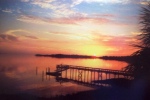WACCASASSA BAY PRESERVE STATE PARK
Accessible only by boat, this preserve is a favorite of anglers because it boasts both saltwater and freshwater fishing. Bordering Florida's Gulf Coast between Cedar Key and Yankeetown, extensive salt marshes and tidal creeks create habitats for saltwater fish, crabs, and shellfish. The park's uplands protect a remnant of the Gulf Hammock that once spanned thousands of acres between the Suwannee and Withlacoochee rivers. Endangered and threatened species-including West Indian manatees, bald eagles, American alligators, and Florida black bears-live or feed within the preserve. Although there aren't any marked foot trails, nature enthusiasts can enjoy wildlife viewing from a canoe. There are several primitive campsites on the Preserve, accessible only by private boat and are available on a first-come-first-served basis. Boat access is from CR 40 in Yankeetown, CR 326 in Gulf Hammock, and Cedar Key.
As a virtually undeveloped area the wildlife is mostly undisturbed. Alligators, otters, bald eagles, dolphins, osprey, raccoons, deer, turtles, great egrets, herons, gulls, pelicans, are some of the common wildlife that can be seen. Manatees occasionally visit the park. Less frequently seen are the Florida black bear, bobcat, skunk, and gray fox.
Waccasassa Bay is rich with cultural history dating from pre-Columbian to early pioneers to the Civil War to modern day timber harvesting. Florida?s early pioneers homesteaded and hunted deer, turkey and bear here. They cut timber and "cow hunted" as well. Yet their activities did not greatly alter the wilderness character of the land. The hammock played a major role in the development of Cedar Key, providing cedar for the pencil factories and palm trees for the fiber factory. Remnants of the boilers once used in the production of brushes and brooms made from the sable palm fibers can be found within the boundaries of the preserve. Another remnant of bygone industry is Salt Island, named for salt kettles found there which were used to extract salt from salt water during the Civil War. Numerous homesites of early settlers as well as Indian sites and artifacts have been found in the preserve.
Disturbance of these sites and the removal of any artifacts is prohibited.
There are four primitive campsites within the Preserve. These campsites are accessible by boat only and are available on a first-come, first-serve basis. Details and directions to the campsites can be found in the Big Bend Segment 6 of the Florida Circumnavigational Saltwater Paddling Trail.

Hotels/Motels
Luxury Gulf Front condos with spectacular views. A tranquil spot on this usually quiet island, yet shops and restaurants are within walking distance. Cedar Key is a picturesque artist/fishing/naturalist village with a diverse history. Within 20 min. of several State Federal wildlife refuges parks. A birders paradise. 877-514-5096
7.5 miles from park*
Boating is accessible only by private watercraft. Boat entrance is available from CR 40 in Yankeetown, CR 326 in Gulf Hammock, and the City Marina in Cedar Key.
The numerous creeks and the shallow waters of Waccasassa Bay Preserve are perfect for canoeing and kayaking. There are no launches within the Preserve. Kayak rentals are available in nearby Cedar Key.
Canoeing is ideal for the nature enthusiast. Endangered and threatened wildlife sighted in the Preserve include manatee, bald eagle, and black bear. The bay and marsh attract large number of osprey, pelicans, rails, wading birds, and waterfowl.
Fishing is abundant with many varieties of salt and fresh water fish, including shellfish. The area has tidal creeks and an immense salt marsh.


